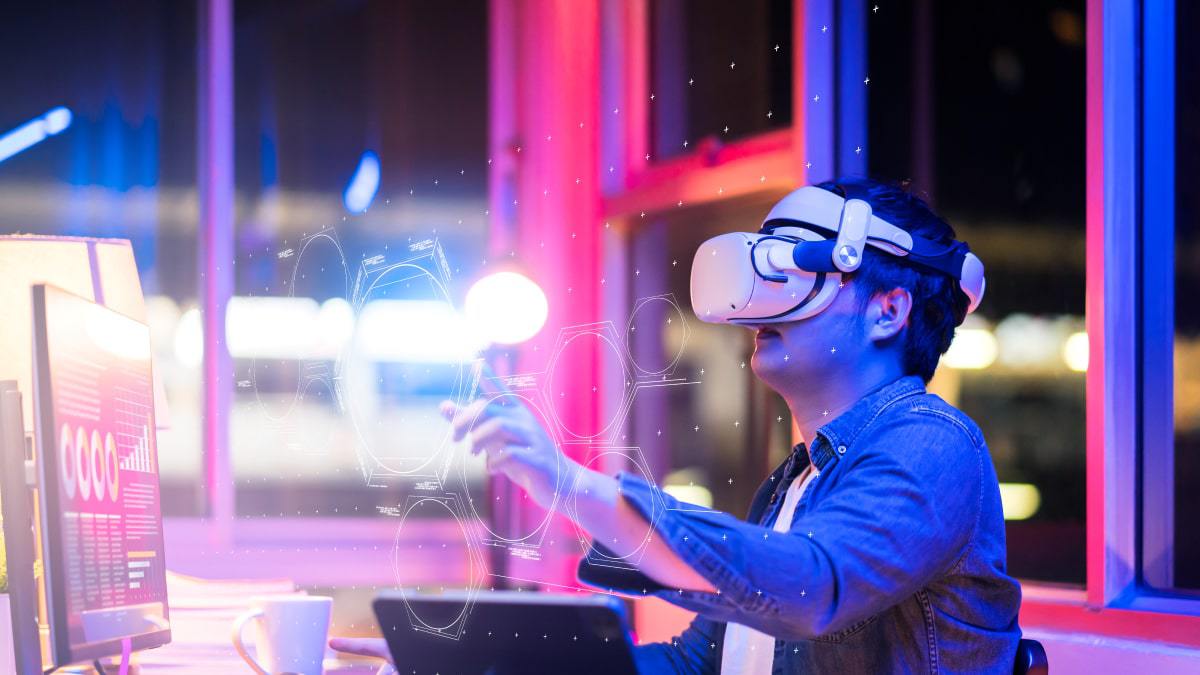How to Navigate the Metaverse? An Era of Immersive Virtual Reality

The internet has undergone remarkable progress since its inception. The emergence of Web 2.0 ushered in a new era of innovation, bringing social networking and interactive experiences to the forefront. However, we now stand at the cusp of yet another transformative technological revolution, the Metaverse.
Although the concept of the Metaverse has been around for decades, it has gained considerable traction in recent years due to recent technological breakthroughs. Navigating the Metaverse means exploring interconnected virtual spaces, which requires advancements in Metaverse AI, VR, and blockchain. As we embrace this new frontier, society’s ways of learning, working, and socializing could undergo radical transformations, shaping the future of our online experiences.
What is the Metaverse?
The Metaverse is a virtual, interconnected, and shared space where people can interact, work, and play using immersive technologies such as virtual reality (VR) and augmented reality (AR). It is a collective digital universe where individuals can engage with each other and digital objects in real time, blurring the lines between the physical and digital worlds.
The idea of the Metaverse originated from science fiction, particularly from the book “Snow Crash” by Neal Stephenson in 1992. The novel depicted a virtual universe known as the Metaverse. The term gained further popularity in the 2000s due to the increasing popularity of online multiplayer games and virtual worlds like Second Life.
The Three Layers of the Metaverse
The Metaverse consists of three distinct layers: the experience layer, the application layer, and the platform layer.
1. Experience Layer
This is the user-facing layer where individuals interact and immerse themselves in the Metaverse. It encompasses virtual environments, augmented reality experiences, and virtual reality simulations. For example, a user wearing augmented reality glasses can explore a digital city overlaying real-world streets, buildings, and interactive elements.
2. Application Layer
This layer comprises the software and services that run within the Metaverse. It includes various applications like social media platforms, gaming experiences, virtual commerce, and education tools. For instance, a virtual conference platform enables users to attend and engage in large-scale events from their homes, offering networking opportunities and live interactions.
3. Platform Layer
At the foundation of the Metaverse lies the platform layer, which provides the infrastructure and tools for developers to create content and applications. These platforms may enable interoperability, digital asset ownership, and decentralized structures. An example is a blockchain-based virtual world where users can own and trade digital assets, such as virtual real estate or rare virtual items.
Together, these three layers form a cohesive and interconnected metaverse offering diverse experiences and opportunities for users and developers alike.
The Rise of Immersive Virtual Reality
Immersive Virtual Reality (VR) has witnessed a remarkable ascent, transforming how we interact with digital content. Enabled by cutting-edge technology, VR offers users a captivating and lifelike experience. From gaming and entertainment to education and training, its applications continue to expand, redefining industries and user experience.
As hardware becomes more accessible and software improves, the potential for VR’s growth seems limitless. With its power to transport users to unimaginable worlds, immersive VR has cemented itself as a pioneering force in shaping the future of human-computer interaction.
The Convergence of VR and the Metaverse
The convergence of Virtual Reality (VR) and the Metaverse marks a groundbreaking evolution in the digital landscape. The Metaverse, an interconnected virtual universe, is enriched by the immersive capabilities of VR, fostering an unprecedented level of interaction and immersion.
Users can now seamlessly access limitless virtual experiences, socialize, and engage in diverse activities. This convergence presents extraordinary potential for entertainment, commerce, and even work, revolutionizing industries and redefining social dynamics. As VR technologies continue to advance, the Metaverse’s significance will grow, transforming the way we perceive and engage with the digital world and bringing about a new era of interconnectedness and possibilities.
Web 3.0 Technologies and the Metaverse
Web 3.0 technologies represent the next evolutionary stage of the internet, marked by decentralization, blockchain integration, and enhanced user experiences. At its core lies the Metaverse, a vast interconnected virtual world merging physical reality and digital space. This immersive, shared environment offers opportunities for boundless communication, collaboration, and commerce.
Utilizing augmented and virtual reality, Web 3.0 empowers users to interact with data and each other in unprecedented ways. Smart contracts and NFTs enable secure transactions and unique digital assets. As Web 3.0 advances, the Metaverse promises to revolutionize industries, redefine social interactions, and pave the way for a more interconnected, virtual future.
The Future of the Metaverse
The future of the Metaverse will embrace decentralized governance powered by AI-driven decision-making alongside human input. Environmental sustainability will be prioritized through energy-efficient practices and decentralized processing. Blockchain and encryption will enhance privacy and security, empowering users to control their data. The virtual economy will evolve with Web 3.0 technologies, allowing seamless cross-platform transactions and empowering creators and entrepreneurs.
The future Metaverse will focus on social impact and inclusivity, offering accessibility features and bridging digital divides. Ethics and content moderation will be vital to fostering a positive virtual environment. A collaborative, inclusive, and responsible approach to governance will ensure the Metaverse’s continued growth and transformation, offering boundless opportunities for users in the digital realm.
Conclusion
The Metaverse surpasses the boundaries of simple gaming or social networking, embodying a revolutionary internet concept that profoundly influences e-commerce, advertising, education, healthcare, and more.
To explore how organizations can achieve a seamless functioning and immersive experience within the Metaverse, don’t hesitate to contact ImpactQA. We enhance performance and scalability by pinpointing bottlenecks and possible user experience concerns. Through performance testing, businesses can guarantee that their metaverse experiences remain responsive and swift, even when handling substantial user traffic.




